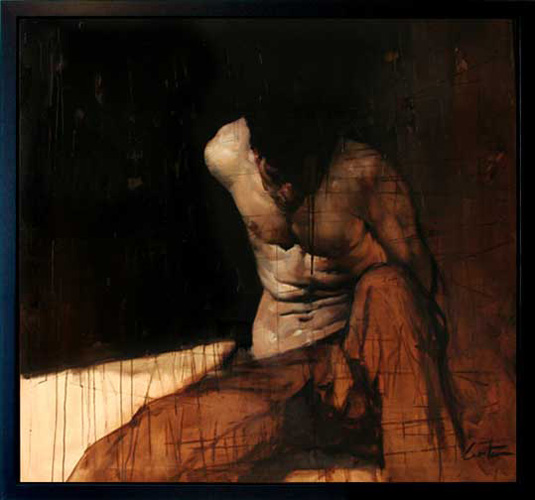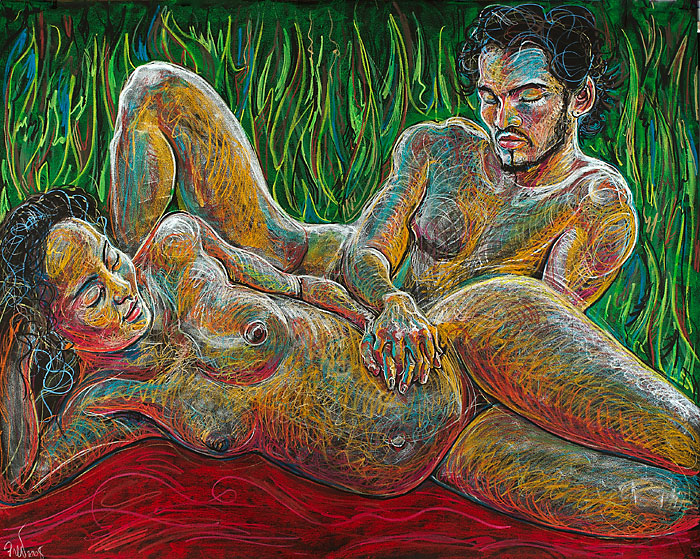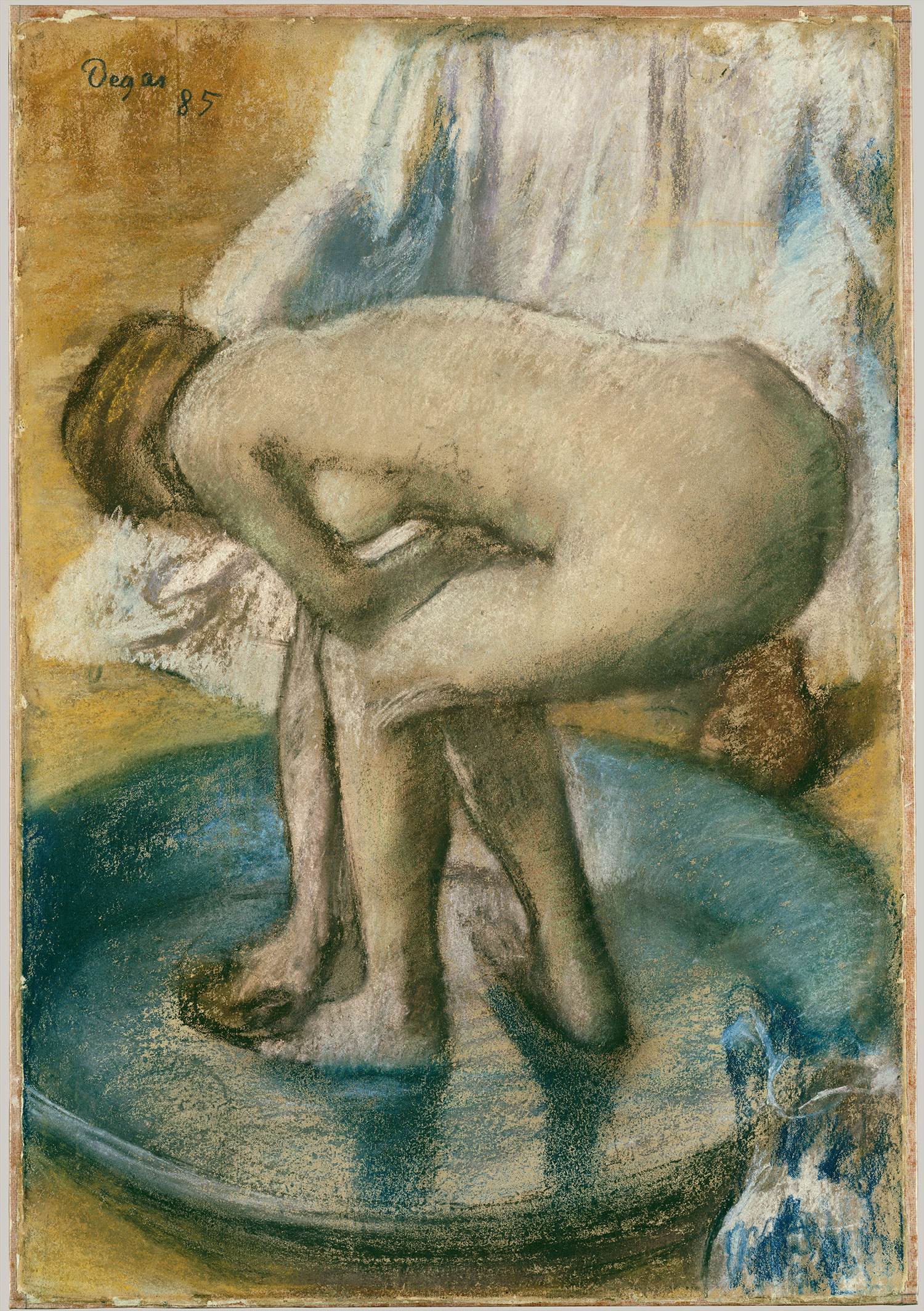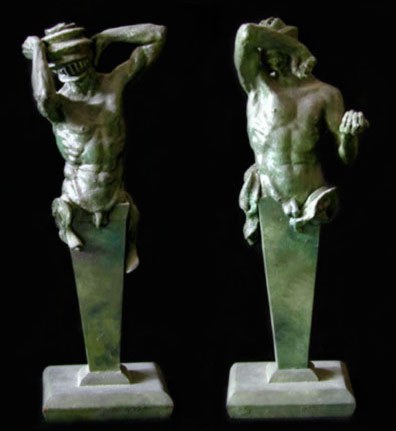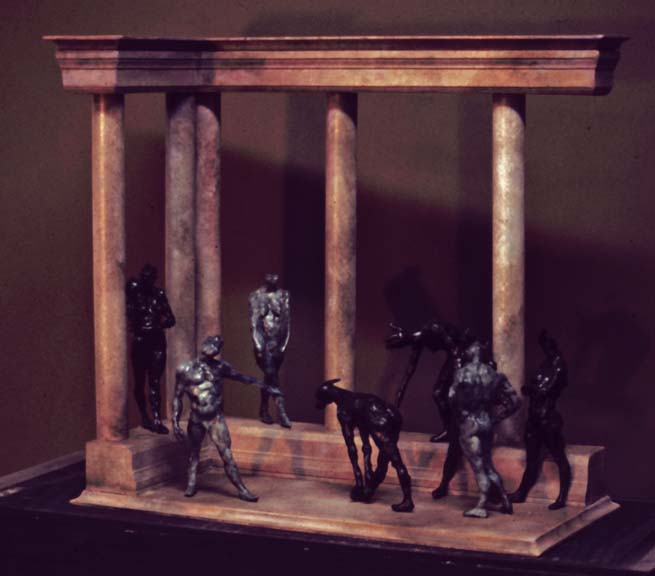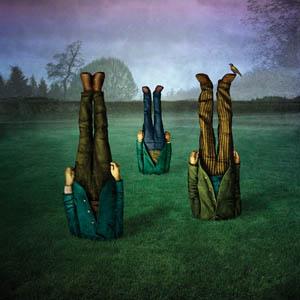George Morton-Clark is a contemporary figural painter. His work, which contains abstract and non-objective elements, attempts to "deconstruct" his perspective on the world to show the necessary truths of human society. According to his artist statement, his art specifically explores the pressures we place on society and vice-versa. Utilizing vibrant colors and distorted figures, he accomplishes just that.
What I like most about his work is that his heavy use of distortion makes for characters that are incredibly emotionally charged. Despite his reluctance to portray detailed or explicit facial expressions, his figures display true human emotion in a way that is both distinct and indescribable. One does not need to look at his work long to be overwhelmed by this aura. The fact that he creates these moods with less visual information adds even further to the effect.
His website may be found here.
Wednesday, July 27, 2011
Tuesday, July 26, 2011
Artist 49: Nicholas Simmons
Nicholas Simmons is a contemporary watermedia artist currently residing in Washington D.C. A native of Iowa, Simmons has studied under significant watercolorists such as Barbara Nechis and Valfred Thelin. According to his website, his subject matter is defined as a "dazzling mix of figures juxtaposed with printed lettering, graffiti, Japanese block prints, neon lights, reflections, and lavish corners of nature.
" The ultimate result is an aesthetically pleasing collage. While thematic elements and concepts appear ambiguous or nonexistent (similar to maggie taylor's work) there is a lot to see and appreciate.
Particularly, my favorite two aspects of his work are his pieces' texture and composition emphasis. Despite using watercolor, his work has a vibrancy of color and texture that is characteristic of paint or pastel. It is a welcome change to see a bridge between these two diverse mediums. Additionally, his work consistently has well-balanced compositions. The relationship between positive and negative space is always artfully delineated.
His website may be found here.
" The ultimate result is an aesthetically pleasing collage. While thematic elements and concepts appear ambiguous or nonexistent (similar to maggie taylor's work) there is a lot to see and appreciate.
Particularly, my favorite two aspects of his work are his pieces' texture and composition emphasis. Despite using watercolor, his work has a vibrancy of color and texture that is characteristic of paint or pastel. It is a welcome change to see a bridge between these two diverse mediums. Additionally, his work consistently has well-balanced compositions. The relationship between positive and negative space is always artfully delineated.
His website may be found here.
Thursday, July 21, 2011
Artist 48: Jenny Oeleis
Jenny Oeleis is a contemporary abstract figurative painter and sculptor. Similar to the impressionists, her paintings are largely composed of broad erratic strokes which capture the feeling of the composition rather than a direct copy. Where she breaks out of the impressionist mold is in her use of unnatural colors, which are typically heavily saturated and bright. Her sculptures, on the other hand, emulate the human form with more accuracy but certainly exaggerate and distort. They are composed of plaster and ceramics. According to her artist statement, she seek a dichotomy of tension and fluidity through the use of vivid color that expresses what one's perceived emotions are at that given moment in time.
What I like most about her work is that it expresses so much with so little detail. Her art is mechanically very simple. However, it surges with emotion in such a way that a single glance allows it to give a powerful impact. Additionally, all of her work is representational yet abstract, which allows for a great degree of visual recognition and emotion at the same time. Indeed, she delicately brings a perfect balance of the two with her work, both sculptural and painting.
Her website may be found here.
Sunday, July 17, 2011
Artist 47: Pnina Granirer
Pnina Granirer is contemporary Canadian mixed media figural artist. After studying at the Bezalel Academy of Art in Jerusalem, she traveled the world studying, eventually settling down in Canada. Her style may be defined as erratic, dynamic, highly textural and abstract. However, in all of her works, figures are the clear focus. They are representational yet also slightly abstracted and distorted. According to her website, she presents the body at the center stage while also dealing with themes such as man's relationship with technology and the dichotomy of male and female.
What I like most about her work is that she is so free with her use of texture and brush strokes. Some may view this style as unrefined or "sketchy" but I see it as a purer form of art that reflects more of the intuition of the artist rather than the cold meticulous articulation of her hand. I'm also smitten with her work comparing man with their technological counterparts. The clash of organic and synthetic has always been an interesting theme for me..
Her website may be found here.
Friday, July 15, 2011
Artist 46: Antoine de Villiers
Antoine de Villiers is a contemporary american figurative painter. A frequent traveller, Antoine has studied numerous styles and art movements from around the globe, paying special attention to incorporating her learnings into her work. Having been exhibited in over 60 exhibitions around the world, her figure works have certainly gained fame as a result of this. Her style may be defined as realistic yet containing abstract elements. According to her artist statement, her artwork attempts to break down reality to its most "barebones" essentials and reconstruct it so that it may illustrate a new perspective.
I'm really fond of the approach she takes. While her artwork is clearly representational, it has lots of unnatural texture and vibrant color. Some times her figures appear hyper-realistic; other times they are distorted and strange. Her painting style, however, is consistent throughout her entire body of work. Each of her paintings utilize similar dynamic lighting and texture. Overall, she has quite a unique perspective on figurative art.
Her website may be found here.
Thursday, July 14, 2011
Artist 45: Christy Lee Rogers
Christy Lee Rogers is a contemporary figural painter. Similar to the art of the Baroque period, Rogers's work is rife with dynamic poses, chiaroscuro, and tenebrism. What separates her art from other baroque works, however, is her widespread use of distortion and abstraction, which is accomplished by adding a high amount of organic line and curves. The result is almost similar to looking at a figure through water. It is hazy and unclear, but at the same time brimming with emotion.
My personal favorite aspect of her work is that her paintings are often borderline abstract but still convey a clear idea of a figural composition. With much of abstract work, it's hard to figure out what is really going on; what it represents and so forth. With Rogers work, however, it is clear despite the haze of her brushwork. The principles of light that govern her art allows the viewer to instantly recognize a figure. The shapes that enshroud it and the distortion of the form pull away but not so much that the representation is lost. She strikes a perfect balance between abstraction and representation.
Her website may be found here.
Her website may be found here.
Wednesday, July 13, 2011
Artist 44: Costa Dvorezky
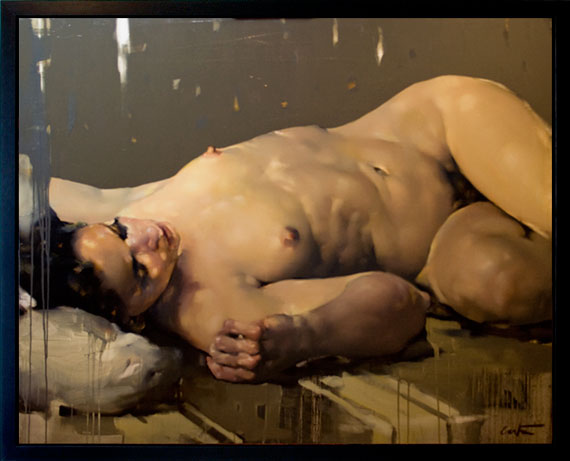 Costa Dvorezky is a russian-born contemporary figural painter. According to his artist's biography, his work attempts to expose the symbols in everyday life through the portrayal of the human form. While these symbols may be unclear at a glance, there is certainly a heavy emotional charge pervading nearly every aspect of his works. Overall, his style may be characterized by "dark and surreal" imagery but much of what makes his work so interesting is that it provokes the viewer to question the nature of the composition. Very little narrative elements are provided and thus the viewer must supply them.
Costa Dvorezky is a russian-born contemporary figural painter. According to his artist's biography, his work attempts to expose the symbols in everyday life through the portrayal of the human form. While these symbols may be unclear at a glance, there is certainly a heavy emotional charge pervading nearly every aspect of his works. Overall, his style may be characterized by "dark and surreal" imagery but much of what makes his work so interesting is that it provokes the viewer to question the nature of the composition. Very little narrative elements are provided and thus the viewer must supply them. Personally, I find his dynamic compositions to be the most appealing part of his artwork. Throughout his entire portfolio, his figures are contorted in a foreign manners with a high degree of tenebrism that is shockingly similar to Caravaggio's work. Another inspiring quality found in his work is his use of running paint lines. These vertical landmarks break his compositions in myriad ways. Strangely enough, they appear right at home with his realistic figures and combine to create some seriously dark imagery.
His website may be found here.
His website may be found here.
Sunday, July 10, 2011
Artist 43: Franc Vozelj
Franc Vozelj is contemporary slovene figural painter. Described as a follower of new age expressionism, Vozelj creates work that appears realistic at a glance but is revealed to be distorted upon closer inspection. To accomplish this effect, Vozelj uses a wide array of abstract elements and paints with vague blocks of color. Furthermore, he frequently utilizes heavy contours on his figures which adds to the sense of abstraction. By submitting to this style of painting, his work is rife with emotion.
What I like most about his art is the soft, dynamic, and angular nature of his painting style. To explain, the texture of his pieces is mostly composed with short broad block-like strokes. This makes the figure look slightly abstracted. His color palette, on the other hand, is typically made up of calm natural colors; the kind you would expect from realist work. When combined, the overall figure appears both natural and abstract at the same time. It's certainly an interesting method.
His website may be found here.
His website may be found here.
Saturday, July 9, 2011
Artist 42: Fred Hatt
Fred Hatt is a contemporary artist who specializes in figure drawing. a self-taught artist, Hatt creates pastel works from live models which focus heavily on line-work rather than modeling with blocks of color. According to his website, the biggest challenge of his art is to create a figure drawing that is also a "portrait". Rather than emphasize the body or the face, Hatt's goal is to show a unified representation of a the sitter and their personality.
My favorite aspect of his work has to be his widespread use of linear texture. By using lines instead of blocks of color, he gives his portraits a heightened sense of motion that's incredibly similar to an impressionist painting. Additionally, the rough unfinished look of his figures makes his work appear visceral and intuitive. Overall, I feel that his heavy use of organic line makes for a great body of work.
His website may be found here.
Thursday, July 7, 2011
Artist 41: Akiko Hoshino
Akiko Hoshino is a japanese contemporary figurative artist. Her preferred mediums are charcoal and pastel. In general, her work may be defined as hyper-realistic. This said, she creates these realistic portraits utilizing soft colors and emphasized dynamic lighting.
What I like most about her work is that she creates art with a humanitarian purpose. According to her statement, she creates to give people hope. In this respect, many of her works feature heavily expressive subject matter such as isolated or visually depressed individuals. By emphasizing this subject matter, she gives the viewer the opportunity to project themselves onto the plight of the characters in her pieces. In doing so, she creates particularly universal works.
Her website may be found here.
Wednesday, July 6, 2011
Artist 40: Jason deCaires Taylor
Jason deCaires Taylor is a contemporary underwater-figurative cement sculptor. A former scuba diving instructor, Taylor had vested a great deal of his youth diving and photographing coral reefs in Malaysia. His passion for the sea combined with his interest in art for public spaces naturally resulted his current sculptures. Practically, his work is produced with cement and lowered into the sea via crane.

There are two primary reasons as to why I find his work so fascinating. First, Taylor takes the incredibly familiar or "normal" and places it in a completely absurd location. It makes the subject matter strange and foreign, as if one is experiencing it for the first time. Second, I'm dumbfounded that he has created work that changes over time and interacts with the surrounding life. As years go by, his pieces with host life; they are built with this in mind. Ironically, Taylors work does not degenerate over time; it grows.
His website may be found here.
Monday, July 4, 2011
Artist 39: Edgar Degas
Edgar Degas was a french proto-impressionist artist who lived during the 19th century. His early to middle life's work consisted mostly of paintings which show borderline impessionistic characteristics. However, despite these qualities, Degas strictly rejected the impressionist label and instead preferred the term realist. Later in life, he shifted media from painting to soft pastel. During this time, his work sacrificed detail for motion and texture. Furthermore, many of his later life's pieces were left unfinished, to which he blamed his failing eyesight.
Without a doubt, my favorite of his works were all created during the latter half of his lifetime. This is largely because his use of texture and movement is much more intuitive. His latter works have incredibly lively compositions that are bursting with energy. Additionally, the unfinished quality many possess seems to emphasize the most important parts of the composition while leaving out all the needless visual information. By being so selective with his drawings, they appear much purer. Lastly, the simplified figures are much more dynamic than his early work. The shadow and light occupy a sharper breadth of space which makes his figures pop out. The effect is certainly convincing. Ultimately, I prefer this naturalist style to his "realist" style.
Sunday, July 3, 2011
Artist 38: Tom Durham
Tom Durham is a contemporary sculptor who combines classical subject matter with surreal and symbolic elements to create new art that speaks to the human condition. According to his Artist statement, these elements come together to form a "personalized" mythology that is derived from the many influences of his life. As is to be expected, his work may be characterized by a high degree of emotional charge and a wide array of dynamic poses. While many artists combine classical and surrealist elements, Durham seems to give both sides an equal share in the final product rather than focus on either. The results are truly unique.
What I like most about his work is that each of his pieces appear to be intuitively constructed. Unlike many classically influenced art, which looks meticulously built with detail in mind, Durham's sculptures appear more fluid; built with less control. To me, this means they appear more human. They are not cold resolute figures, but rather warm and saturated in movement. Overall, I believe his work definitely succeeds in speaking to the human condition.
Friday, July 1, 2011
Artist 37: Philip Buller
Philip Buller is a contemporary figural painter who heavily utilizes ambiguity and abstract elements. Rather than paint the figure in full, Buller creates works composed of fragments arranged in a meaningful way that he admits is not intrinsic but rather "resolved" over a period of time. He compares this development to "a fruit in an orchard." According to his artist statement, he prefers this method because it keeps his work outside of the realm of reproduction and in the realm of experience.
The ultimate result of his work is psychologically stunning. It is akin to a recording of visual consciousness; like a raw stamp of one's mind processing events. To this extent, his art has a concrete sense of naturalism about it. It's certainly not realistic in the traditional sense, but it reads that way. This is fundamentally what I like most about his art. It is both realistic and unrealistic. It appears meaningful yet not meaningful. Overall, it's thought-provoking.
His website may be found here.
Thursday, June 30, 2011
Artist 36: Eric Zener
Eric Zener is a contemporary photo-realist figurist painter whose work usually depicts individual figures--many of which are under water or near it. According to an interview with Art Business News, Zener is a self-taught painter and he creates his work as a cathartic relief for himself. He states: "My work is about psychological turning points and transformations and risk, taking that proverbial leap of faith, balanced with that quest for finding refuge, finding quietness and stillness and escapism."
For the most part, I feel that his work captures that introspective nature he describes. Each of his pieces have a certain sense of contemplativeness about them. They inspire self-reflection and consideration. Without a doubt, this is my favorite aspect of his work. However, the photo-realistic qualities are equally beautiful. The details of the water are particularly high quality. Ultimately, though, the appearance of isolation and notions of escapism are the main draws for me.
His website may be found here.
Wednesday, June 29, 2011
Artist 35: Maggie Taylor
Maggie Taylor is a contemporary figural and surrealist artist who primarily uses a flatbed scanner and photoshop to create her works. According to her artist statement, she scans the myriad items that she collects from ebay and flea markets and incorporates them into compositions. Similarly, the humans who populate her works are also scanned in photographs via flatbed. Very little of her artwork is actually hand made for the occasion. Rather, most is assembled "intuitively" to mirror the effects of a photograph.
What I like most about Taylor's work is that each of her pieces emit an aura of mystery. The fine details coupled with the unique positioning of the figures seem to allude to a greater meaning or narrative. Interestingly, most of these allusions are admittedly a farce. According to her artist statement, "There is no one meaning for any of the images, rather they exist as a kind of visual riddle or open-ended poem, meant to be both playful and provocative." In that respect, she certainly accomplishes her goal. Most of the fun in viewing her works is searching for an ultimate meaning that simply is not there.
Her website may be found here.
Tuesday, June 28, 2011
Artist 34: Chris Mars
Chris Mars is a contemporary abstract figural painter whose focus is on revealing the inner beauty of those society "labels" as monsters. According to his artist statement, this body of work is largely inspired by his older brother Joe, who was diagnosed with schizophrenia when he was sixteen years old. As a child, Chris met face to face with the mental institutions his brother was frequently whisked away to and it profoundly influenced him to change the way people perceive those with mental illnesses. From that point on, his work attempted to show the ill as beautiful rather than monsters. For the most part, his artwork certainly reflects this goal.
 While the physical artwork may not appeal to standard conventions of beauty, the concept is clear and evident within each composition. He states: " My work is about looking beyond the outer to the inner, and finding with this the true definition of Beauty - which is beyond form." This is particularly what I find so fascinating about his art. It is fundamentally personal, yet at the same time, it speaks universally.
While the physical artwork may not appeal to standard conventions of beauty, the concept is clear and evident within each composition. He states: " My work is about looking beyond the outer to the inner, and finding with this the true definition of Beauty - which is beyond form." This is particularly what I find so fascinating about his art. It is fundamentally personal, yet at the same time, it speaks universally.His website may be found here.
Sunday, June 26, 2011
Sketch Update 2: Master Studies
Artist 33: Robert Schefman
Currently a Professor at the College of Creative Studies in MI, Robert Schefman creates hyper-realistic paintings that contain allegorical, witty, and emotional subject matter. For the most part, his work is characteristic of a consistent realist style. However, many of his compositions and brushwork resemble the baroque artist Vermeer. To this extent, his art predominantly emphasizes figures and fabrics with special attention paid to portraying unique perspectives on familiar art themes.
My favorite of his works, however, is his series on famous works throughout art history. In these pieces, he offers the viewer a unique perspective on iconic works that nearly everyone is familiar with. Michelangelo's Sistine chapel, Titian's Venus of Urbino, and Botticelli's Birth of Venus are a few notable examples. With these works, Schefman reminds us to consider the process of creating these masterworks. No doubt, this is result of his work in theater set design.
His website may be found here.
His website may be found here.
Friday, June 24, 2011
Artist 32: Steven Assael
Steven Assael is a contemporary American realist painter. Working exclusively with live models, he creates works that combine naturalistic techniques with an overall classical aesthetic. Ultimately, this combination results in an array of beautiful figure pieces that appear both incredibly realistic as well as slightly idealized. Additionally, many of his works contain contemporary subject matter such as clothing and scenery. In this respect, Assael clearly conveys a modern sense of style with his portfolio.
What I like most about his pieces is that he achieves such a high level of detail while still retaining the texture of his brush strokes. This deliberate effort clearly distinguishes his work from photographs yet does not detract from the convincingness of the overall composition.
More of his work may be found at his website here.
Thursday, June 23, 2011
Artist 31: Kathryn Jacobi
Kathryn Jacobi is a contemporary painter and printmaker. Equipped with a classical education in figure study, she creates realist paintings of figures with a high degree of chiaroscuro and Tenebrism. Interestingly, the subject matter of her artwork occupies a wide range of topics and emotions. Rather than stick with straight representational works, Jacobi combines realist imagery with abstract and imagined locales. However, the common thread between all of her works is her use of dynamic lighting and exquisite level of detail. According to her artist's biography, she always works on two seperate bodies of work consecutively. One is from direct experience with old photographs. The other is from her imagination.
Personally, I find Jacobi's work to be certainly inspirational. Her representational works are highly reminiscent of Carravaggio but with more attention paid to showing texture. As for her imaginary works, they exude a potent sense of emotional vigor without sacrificing detail or content. Overall, both of her preferred styles are executed incredibly well. Seeing how she maintains a distinctive style throughout both endeavors is equally inspirational.
Her website may be found here.
Her website may be found here.
Wednesday, June 22, 2011
Artist 30: Jason Shawn Alexander
Jason Shawn Alexander is a contemporary figurative painter and draftsman whose focus is portraying emotionally charged scenes. According to his website, his work sticks to the primary emotional condition of humanity as it is "what is really important." As such, his work does not fit clearly with any particular style. Instead, his art is a modern amalgamation of hyper-realism and abstract elements.
My favorite of Alexander's works is his series on mourning. Each of them portray a particular stage in the process and utilize a wide array of methods and styles to getting the message across. In the example to the right, you can see the figure degenerate from a fully shaded human with flesh and form to a contour drawing and further to just lines. What I find so particularly interesting about these works is that they combine realistic and abstracted qualities together in an attractive way that really pushes emotion and drama. He skillfully controls the amount of visual information the viewer may see in order to focus the attention to particular spots. Overall, he creates some incredible work.
His website may be found here.
Monday, June 20, 2011
Artist 29: Jenny Saville
Drawing heavily from classical tradition, Patricia Watwood creates figural paintings which fuse renaissance and contemporary aesthetics together. To this extent, many of her works depict "mythological, allegorical, and narrative themes" as well as ancient Greek motifs and color schemes. As far as her contemporary influence, it is evident that her figures are painted anatomically correct and appear less archetypal than renaissance figures. Clearly, her models are unique examples of real-life people rather than heavily idealized figures. According to her artist statement, the recurring theme in her work is "the spiritual human presence of the subjects in the paintings."
What I like most about her work is that it appears fresh and new despite the myriad classical references and color schemes. The realistic portrayal of the figures in combination with the traditional style gives her art a nice balance that is aesthetically pleasing, familiar, and fresh all at the same time.
Her website may be found here.
What I like most about her work is that it appears fresh and new despite the myriad classical references and color schemes. The realistic portrayal of the figures in combination with the traditional style gives her art a nice balance that is aesthetically pleasing, familiar, and fresh all at the same time.
Her website may be found here.
Saturday, June 18, 2011
Artist 28: Mark Gibbons
Mark Gibbons is a concept artist and game developer currently working at Blizzard Entertainment. Drawing influence from comic books and video games, Gibbons creates works that he describes as overblown, muscular, and angular figures with heavy chiaroscuro. To his credit, this is just what he delivers. his figures are dark, proportionally exaggerated and dynamically lighted. Gibbons has worked for the games industry since the early nineties. His employers range from The Games Workshop, to Sony and currently Blizzard.
I find his work to be particularly interesting because of his unique combination of comic book style and traditional design elements. His portfolio of art clearly portrays dynamic figures with comic book contours however, it also contains painterly textures and almost caravaggio-esque lighting techniques. His rendition of Shelley's Frankenstein is a perfect exemplar of this.
More of his work may be found at his website here.
Friday, June 17, 2011
Sketch Update 1: Sisyphus
Here are some tentative sketches that I have made in preparation of my first piece based on the ancient Greek myth of Sisyphus.
For those unfamiliar with the story, Sisyphus was a trickster who fooled the gods by escaping his own death. Out of anger, the gods punished him by sending him to Tartarus with the pointless task of pushing a rock up and down a mountain for all eternity. post-modern philosopher Albert Camus took the myth to be representative of his own school of thought, Absurdism. According to his doctrine, Sisyphus's fate mirrors that of the modern man as both are forced into an existence of perpetual work without meaning.
Let me know what you guys think of my sketches so far. Ultimately, I plan on doing two pieces covering Sisyphus. One will illustrate his trek up the mountain and the other down.
Subscribe to:
Posts (Atom)













